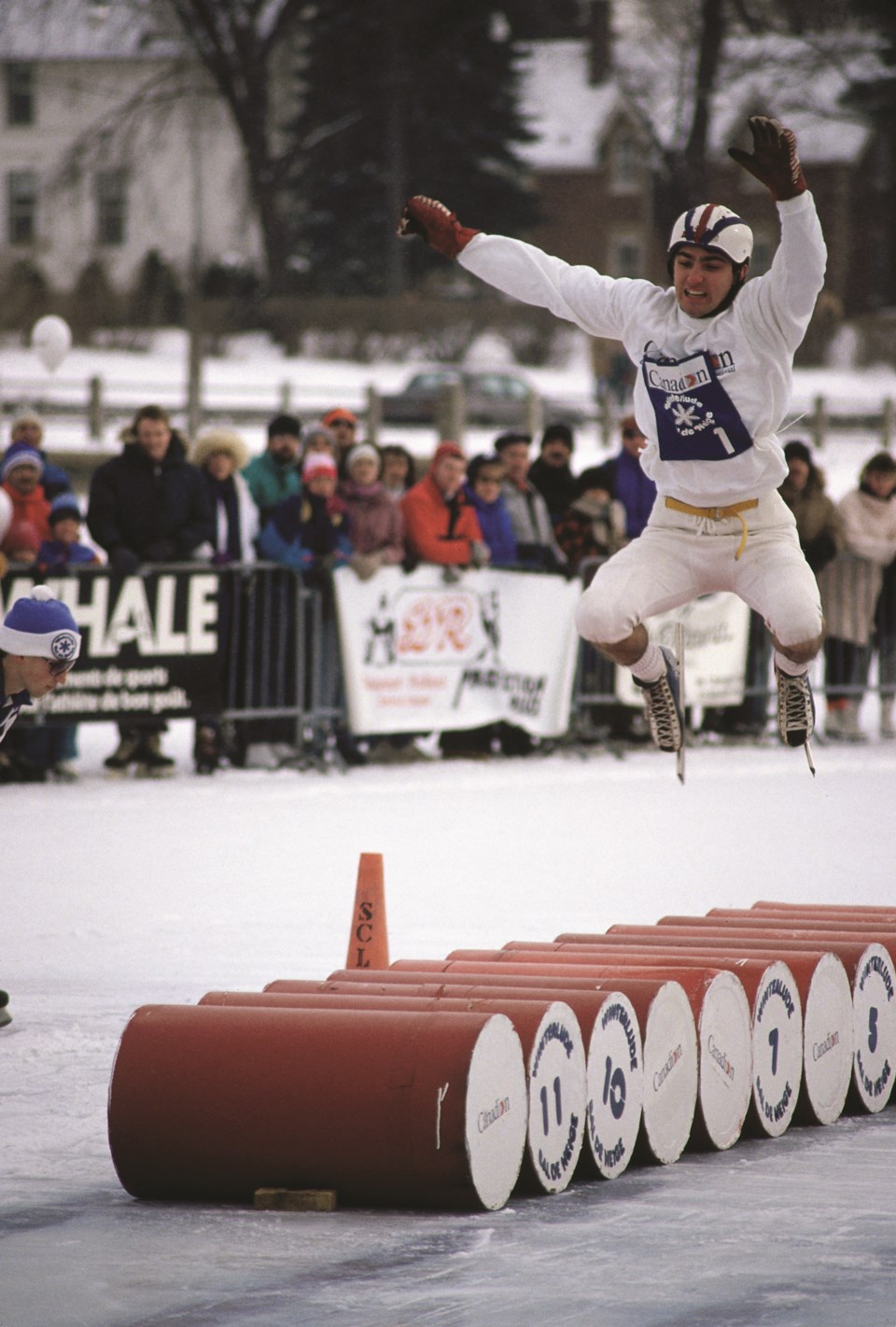In this Olympic season I’d like to talk a bit about a pure, backyard-bred, gauntlet-throwing event that many of my generation were convinced was once a part of the Winter Games. It wasn’t, but given some of the arcane, deadbeat events of today’s Olympiads it should have been. I’m talking, of course, about the barrel jump.
A clip of barrel jumping was long-featured on the trailer to ABC television’s infamous Wide World of Sports. In the grainy black and white footage, a dude skates up to a row of barrels at Mach speed, leaps feet forward like a broad-jumping track star, hits the last barrel with his tailbone, and appears to shatter his pelvis. In the pantheon of Agony of Defeat, it was right up there with the upside-down ski jumper wiping the hay bales off the side of a jump later in the same montage. Still, since it was the kind of thing you could imagine doing with your buddies—or at least your Norwegian buddies—it seemed, somehow, Olympic in scope.
Though it never made it to the Olympics, it wasn’t for lack of trying.
Few will be surprised to hear that long jumping on skates was an informal sport in nineteenth-century Holland. It grew naturally out of obstacle races in which speed skaters jumped fences, walls, and man-made barriers. During the 1920s and 1930s, barrels were often placed to mark the course boundaries. Skaters amused themselves and spectators before and after races by laying the barrels on their sides and jumping them.
Eventually the tomfoolery was formalized into its own competition: the skater would circle the rink a few times to pick up speed, then, at about 50 km/h, try to leap a batch of wooden (later fibreglass) barrels laid side by side by side on the ice. American speedskater Edmund Lamy set the first known record with a jump of 27’8” (8.4 metres) at Saranac Lake, New York, in 1925, and the distance remained a record for more than a quarter of a century. Olympic gold-medal speedskater Irving Jaffee made his mark by organizing the first barrel-jumping tournament, at Grossinger’s Country Club in the Catskills, in 1951. Jaffee also standardized barrel size at 16” (40 cm) wide and 30” (76 cm) long. Terrance Brown set a new record by jumping 15 barrels (28’3” or 8.6 metres), at the second World Championships at Grossinger’s in 1952. The present record of 18 barrels (29’5” or almost 9 metres) was set by Yvon Jolin of Canada on Jan. 25, 1981. The women’s record was set in LaSalle, Que., by Marie Josee Houle, who jumped 11 barrels (22’5” or 6.8 metres) on March 1, 1987. Yay team Canada! Obviously, we—along with the barrels—would kick some serious international butt in this event.
One difficulty was the height required to avoid serious injury. The skater had to leap a couple metres into the air to make it over, launching much like an airplane. “We must have speed and guts,” said Gilles Leclerc, one-time president of the Canadian Barrel Jumping Federation (CBJF), which tried for 25 years to get the sport included in the Olympics. In 1992, the CBJF sent a jumper to a Lillehammer winter-sports festival. But the demo was canned because of injury fears. A video of the “sport” was shown instead. Olympic officials remained unconvinced.
“I’ll admit it’s a brutal sport,” said a spokesman. “Nobody really makes it. Everybody falls on their backside.”
Leclerc, however, a former Canadian champ, says barrel jumping isn’t dangerous because experts wear padded bodysuits and know how to land. Even so, he says, the notion of barrel jumping in the Olympics is dead. “Fewer countries are involved now, and people are discouraged. When you’re refused all the time, all the good jumpers stop training.”
He could have been talking about Women’s Ski Jumping, but they actually prevailed.
Recall that while men ski jumped at the Olympics since the first Winter Games nearly a century ago, the FIS didn’t allow women to compete until 2014, and even then, insisted they wear hip padding on their suits. Ostensibly this was for “safety” but the women soon figured out it was to accentuate their curves and served no useful performance purpose. In its 2020 specifications, FIS removed the hip panel requirement, but the fight for equality clearly extends beyond ski suits. “It’s not like the suit was changed and everyone was like, ‘Yeah equality in ski jumping!’” a spokesperson told NPR. On the professional circuit, women still take home 70 to 80 per cent less prize money than men and there are fewer chances to compete, both on the World Cup circuit and at the Olympics.
Although excited to attend her first Olympics in Beijing, Canadian ski jumper Abigail Strate notes that there are only two ski-jumping events for women compared to four for men. “That’s that many more opportunities at an Olympic medal, that’s that many more opportunities to put yourself out there and show yourself as an athlete,” she says.
Which begs the question: if the Olympics actually had gotten its mitts on barrel jumping would it have been a case of careful what you wish for?
Leslie Anthony is a Whistler-based author, editor, biologist and bon vivant who has never met a mountain he didn’t like.




